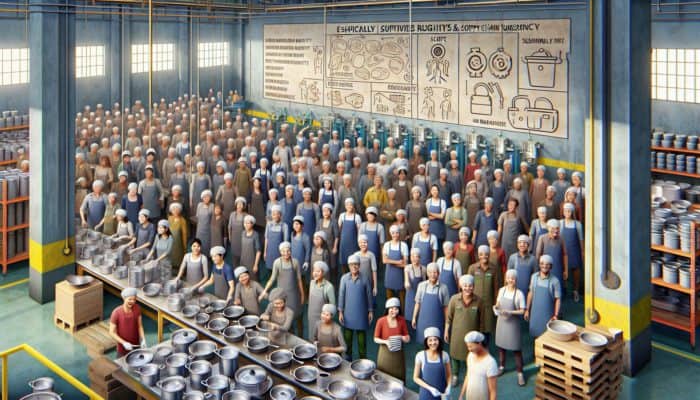Discover the Benefits of Choosing Sustainable Cookware Crafted from Eco-Friendly Materials
The journey to selecting eco-friendly cookware begins with a thorough understanding of materials that prioritize sustainability. By opting for eco-friendly cookware, you not only elevate your culinary experiences but also embrace a lifestyle committed to reducing environmental harm. It’s crucial to select materials that ensure your kitchenware is both high-performing and environmentally friendly. This conscientious choice enables you to indulge in cooking while making a positive impact on the planet, aligning your kitchen practices with your values of sustainability and ethical consumption.
Exploring the Key Characteristics of Eco-Friendly Materials for Cookware

An eco-friendly material is defined by its sustainability and renewability. These materials are derived from renewable resources, require minimal energy during their processing phase, and maintain a low ecological footprint throughout their lifecycle. When assessing materials for cookware, it is essential to evaluate their manufacturing processes, energy consumption, and waste production. Ideally, these materials should be biodegradable or easily recyclable, allowing them to return to nature or be repurposed into new products at the end of their useful life. This comprehensive approach to material selection is vital for fostering a sustainable kitchen atmosphere.
Take bamboo, for instance. It is a rapidly renewable resource that flourishes abundantly without the need for harmful pesticides or synthetic fertilizers. Its natural strength and lightweight attributes make it a favored option for kitchen utensils and serving dishes. Likewise, stainless steel is highly regarded for its durability and resistance to corrosion, providing a long-lasting product that does not leach harmful chemicals into your food or the environment, making it an excellent choice for all your culinary endeavors.
Exploring Trending Eco-Friendly Cookware Options for Your Kitchen
A variety of materials are synonymous with eco-friendliness in the cookware industry. First and foremost, stainless steel excels due to its durability and complete recyclability, establishing it as an outstanding choice for a sustainable kitchen. Its non-reactive nature ensures that it neither interacts with food nor releases harmful substances, contributing to a healthier cooking experience.
Another remarkable sustainable option is cast iron. While it may be heavier and requires some upkeep, its durability is unparalleled. A well-maintained cast iron skillet can last a lifetime or even longer, significantly minimizing the need for replacements. Additionally, cast iron is celebrated for its exceptional heat distribution, making it a preferred choice among both professional chefs and home cooks alike.
Ceramic cookware is renowned for its non-stick capabilities and is often crafted from natural materials, free of toxic chemicals, which makes it an outstanding choice for health-conscious individuals. Finally, bamboo, often underestimated, is ideal for utensils and cutting boards due to its sustainable characteristics and natural antibacterial properties. Each of these materials provides unique advantages for your kitchen while adhering to principles of sustainability, making them worthy of your consideration.
Navigating the Risks of Toxic Substances in Your Cookware Choices
Finding your way through the cookware market can be overwhelming, especially when it comes to avoiding harmful substances. Many conventional non-stick cookware options are made with perfluorooctanoic acid (PFOA) and polytetrafluoroethylene (PTFE), both associated with various health issues and environmental dangers. Therefore, when selecting cookware, it is crucial to scrutinize labels and choose products free from these chemicals, ensuring a safer cooking environment for you and your family.
Cookware composed of eco-friendly materials, such as ceramic or cast iron, not only avoids these hazardous substances but also promotes health-conscious cooking practices. By choosing to support brands that prioritize safety and sustainability, consumers can drive a shift away from toxic materials in the cookware market. This transition is essential for safeguarding individual health and the environment, as the production and disposal of harmful materials have a significant impact on our ecosystems. Opting for safer alternatives is a powerful step toward fostering a sustainable future.
Evaluating the Manufacturing Processes of Eco-Friendly Cookware

The process of selecting eco-friendly cookware goes beyond merely choosing materials; the manufacturing processes involved are equally vital in determining the environmental impact of a product. Understanding these processes empowers consumers to make informed choices that align with their sustainability values and ethical responsibility, leading to more conscious purchasing decisions.
Prioritizing Energy Efficiency in Cookware Production for Environmental Benefits
Manufacturing processes that emphasize energy efficiency play a crucial role in reducing the carbon footprint associated with cookware production. Many companies are now investing in innovative technologies that enable them to create cookware using significantly less energy compared to traditional methods. For instance, manufacturers may employ induction heating systems or utilize solar energy to power their production lines, dramatically minimizing their ecological impact.
When purchasing cookware, seek brands that offer transparency about their energy consumption and production methods. This openness serves as a benchmark for evaluating their commitment to sustainability. By selecting energy-efficient cookware, consumers not only support environmentally responsible companies but also contribute to a broader movement advocating for sustainable practices across various industries.
Implementing Effective Waste Management Strategies in Cookware Manufacturing
Waste management practices are another crucial aspect of the manufacturing process that consumers should consider. Brands that adopt effective waste reduction strategies demonstrate a commitment to sustainability that extends beyond the point of sale. This may involve recycling scrap materials, utilizing biodegradable packaging, and minimizing production waste through innovative design practices.
For example, some cookware manufacturers implement a closed-loop manufacturing system, where waste materials are repurposed into new products instead of being discarded. This approach not only reduces landfill contributions but also aligns with the principles of a circular economy. By supporting brands that prioritize responsible waste management, consumers can play a significant role in promoting sustainability within the cookware sector.
Ensuring Ethical Labor Practices in Cookware Manufacturing

Supporting companies that adhere to ethical labor practices is essential for nurturing a sustainable supply chain. Fair labor conditions ensure that workers are treated with dignity and respect, and their rights are safeguarded throughout the production process. Ethical practices encompass fair wages, safe working conditions, and compliance with labor laws.
When evaluating cookware options, take the time to research the companies behind these products. Look for brands that maintain ethical sourcing policies and are transparent about their supply chain practices. By choosing to invest in products from these companies, consumers contribute to a marketplace that values both people and the planet, paving the way for a more sustainable future.
Maximizing Durability and Longevity in Your Cookware Choices
The durability and longevity of cookware are critical factors when assessing the sustainability of your kitchenware. By selecting durable products, you significantly decrease the need for replacements, which in turn reduces waste and fosters a more sustainable lifestyle.
Investing in Long-Lasting Cookware Solutions for a Sustainable Kitchen
Choosing cookware made from high-quality materials is essential for ensuring its longevity. Options like cast iron and stainless steel are designed to withstand the test of time, often evolving into family heirlooms passed down through generations. These materials can endure high temperatures and heavy usage, making them ideal for daily cooking tasks.
Investing in premium cookware may require a higher initial investment, but the long-term benefits far outweigh this upfront cost. Durable cookware leads to less waste over time, as it does not require frequent replacement, thereby conserving resources and reducing your overall environmental impact. This strategy not only enhances sustainability but also enriches your cooking experience, allowing you to enjoy your kitchen tools for many years to come.
Essential Care and Maintenance Guidelines for Prolonging Your Cookware’s Life
Proper care and maintenance are crucial for extending the life of your eco-friendly cookware. Each material has specific care requirements that ensure durability and optimal performance. For instance, cast iron cookware necessitates seasoning to develop its non-stick surface and to prevent rust, while stainless steel can be maintained using mild detergents to preserve its shine without causing damage.
Utilizing gentle cleaning techniques, avoiding harsh chemicals, and thoroughly drying cookware can significantly enhance its lifespan. Familiarizing yourself with the best care practices for your specific cookware materials is a wise investment in sustainability. The more you care for your kitchen tools, the longer they will serve you, thus minimizing waste and fostering a responsible kitchen environment.
Choosing Repair Over Replacement for Sustainable Cookware Management
When faced with worn or damaged cookware, consider whether repair is a feasible option before opting for replacement. Many cookware pieces, particularly those made from resilient materials, can often be restored with minimal effort. For example, a scratched non-stick pan may be resurfaced, while a chipped ceramic dish might still be useful for non-food-related tasks.
In a world increasingly focused on consumption, adopting a mindset of repairing rather than replacing is vital for sustainability. Engaging with local artisans or following DIY repair tutorials empowers you to restore your cookware instead of contributing to landfill waste. This approach not only saves you money but also reinforces your commitment to environmental responsibility.
Prioritizing Health and Safety in Your Cookware Selections
Health and safety considerations are fundamental when selecting eco-friendly cookware. It is essential to choose products that protect both your health and the environment while upholding high culinary standards.
Selecting Non-Toxic Coatings for Safe Cooking Practices
When it comes to non-stick cookware, prioritizing non-toxic coatings is of utmost importance. Conventional non-stick surfaces often contain harmful chemicals that can leach into food, presenting serious health risks. In contrast, many brands now offer non-toxic alternatives that are free from harmful substances such as PFOA and PTFE.
Cookware coated with ceramic or silicone provides a safe, non-stick surface that doesn’t compromise health. These materials are not only safer for cooking but also easier to clean, contributing to a more enjoyable cooking experience. By prioritizing non-toxic options, you create a healthier kitchen environment for yourself and your family, ultimately enhancing your overall cooking experience.
Ensuring Heat Resistance and Safety in Your Cookware Choices
Selecting cookware that can endure high temperatures without releasing harmful substances is crucial for health and safety. Many eco-friendly cookware materials, such as stainless steel and cast iron, are engineered to withstand high heat, ensuring safe cooking without the risk of harmful chemical release.
Furthermore, it is imperative to verify that the cookware is free from synthetic materials that may degrade at elevated temperatures. When selecting your cookware, pay close attention to the manufacturer’s guidelines regarding maximum heat tolerance to avoid potential safety hazards in your kitchen.
Exploring Allergen-Free Cookware Choices to Accommodate Diverse Diets
Given the rising prevalence of various dietary needs and preferences, opting for allergen-free cookware options is essential for accommodating diverse lifestyles. Numerous cookware materials, such as stainless steel and glass, are naturally free from common allergens, making them safer choices for individuals with sensitivities.
Incorporating allergen-free cookware into your kitchen not only enhances safety but also promotes inclusivity in meal preparation. By selecting materials that cater to a variety of dietary needs, you contribute to a healthier cooking environment for yourself and your guests, ultimately fostering well-being in every meal prepared.
Prioritizing Ergonomic Design for Enhanced Comfort and Safety
The design of cookware significantly influences the comfort and safety of its use during cooking. Cookware featuring ergonomic handles and thoughtfully designed elements can prevent strain and elevate the overall cooking experience. When choosing cookware, consider options that provide comfortable grips and balanced weight distribution.
Investing in ergonomically designed cookware can improve cooking efficiency and reduce the risk of injury. By prioritizing comfort alongside functionality, you create a kitchen environment that supports both your culinary creativity and your physical well-being.
Understanding the Environmental Impact of Cookware Usage
The environmental impact of cookware extends beyond its production; how you use and care for your cookware significantly influences sustainability as well. Embracing practices that minimize energy and resource consumption during cooking can contribute to a more sustainable kitchen.
Reducing Energy Consumption While Cooking for a Greener Kitchen
One of the most effective methods for reducing your environmental footprint is by choosing cookware that heats efficiently. Cookware designed for rapid heat conduction, such as copper or stainless steel, allows for quicker cooking times, thereby decreasing energy usage.
Moreover, utilizing lids while cooking helps retain heat and shortens cooking time, further conserving energy. By being mindful of your cookware’s heat conduction properties and implementing energy-saving techniques, you can make a significant impact on your overall energy consumption and environmental footprint.
Conserving Water Usage During Cookware Cleaning Processes
Cleaning cookware often requires substantial amounts of water, making it a resource-intensive endeavor. Opting for cookware that is easy to clean – such as non-stick or smooth-surfaced options – can help significantly reduce water usage.
Additionally, adopting mindful cleaning practices, such as soaking pots and pans instead of letting water run continuously, can further conserve this precious resource. By making thoughtful choices in your cleaning methods, you contribute to a more sustainable kitchen environment while ensuring that your cookware remains in excellent condition.
Responsible Disposal of Cookware at the End of Its Lifecycle to Promote Sustainability
Understanding how to dispose of cookware responsibly at the end of its lifecycle is a vital component of sustainability. Rather than simply discarding old cookware into landfills, consider exploring recycling or repurposing options for the materials. Many stainless steel and cast iron items can be recycled, while ceramics can sometimes be repurposed for artistic projects or construction purposes.
Research local recycling programs or community initiatives that accept cookware for recycling. By taking proactive steps in your disposal methods, you can help reduce waste and promote environmental sustainability even at the end of a product’s life cycle.
Evaluating the Sustainability of Cookware Packaging and Shipping Practices
The packaging and shipping of cookware are often overlooked elements of sustainability. However, these factors significantly affect the overall environmental impact of a product from the moment it is manufactured to when it arrives in your kitchen.
Selecting Minimalist Packaging to Reduce Environmental Waste
Opting for cookware that arrives with minimalist packaging can dramatically decrease waste. Excessive packaging not only contributes to landfill overflow but also signifies unnecessary consumption of resources.
Choosing brands that prioritize sustainable packaging solutions, such as compostable materials or minimalist designs, allows consumers to align their purchases with eco-friendly values. By making conscious decisions regarding packaging, you play a significant role in mitigating environmental impact right from the outset of your cookware’s journey.
Supporting Recyclable Materials in Cookware Packaging for a Sustainable Economy
Cookware packaged in recyclable materials contributes to a more sustainable economy. When selecting products, look for those packaged in cardboard, paper, or other recyclable substances rather than plastic.
Recycling packaging materials helps divert waste from landfills and promotes a circular economy, wherein materials are reused and recycled instead of discarded. By supporting brands that utilize recyclable materials, you reinforce the importance of sustainability in product design and packaging.
Assessing Efficient Shipping Practices to Minimize Carbon Footprint
The shipping methods employed by cookware brands can significantly affect their carbon footprint. Companies that adopt energy-efficient shipping practices, such as consolidating shipments or utilizing electric vehicles, exhibit a strong commitment to sustainability.
Whenever possible, opt for brands that prioritize eco-friendly shipping methods. Supporting companies that invest in reducing emissions during shipping contributes to a more sustainable overall product lifecycle, allowing you to align your purchases with environmentally conscious values.
Understanding Certifications and Labels for Eco-Friendly Cookware Choices
Navigating the landscape of eco-friendly cookware can be complex, but familiarizing yourself with certifications and labels can simplify the decision-making process. These indicators assist consumers in identifying products that adhere to specific environmental standards and practices.
Recognizing Established Eco-Certifications for Informed Choices
When selecting cookware, look for reputable eco-certifications such as EcoCert or GreenGuard. These certifications are awarded to products that meet stringent environmental standards, ensuring that they are safe for both consumers and the planet.
Becoming familiar with these labels empowers you to make informed purchasing decisions, contributing to a marketplace that values sustainability and eco-friendliness. Brands bearing these certifications often provide additional transparency regarding their materials and manufacturing processes, further enhancing consumer trust and confidence.
Understanding the Importance of Product Labels on Eco-Friendly Cookware
Comprehending the significance of various labels can enhance your ability to select eco-friendly cookware. Product labels frequently provide insights into material safety, recyclability, and manufacturing practices. Educating yourself about the meanings behind these labels can guide you toward products that resonate with your values.
For instance, a label stating “PFOA-free” indicates that the cookware is devoid of harmful chemicals. By interpreting these labels, you can confidently select products that prioritize health and environmental sustainability, ensuring your kitchenware supports a greener lifestyle.
Verifying Eco-Friendly Claims Made by Cookware Brands for Consumer Protection
Consumer awareness is vital when it comes to validating eco-friendly claims made by cookware brands. Not all claims are equally credible, so conducting thorough research is necessary. Look for brands that provide clear and detailed information about their materials, production methods, and certifications.
Online reviews and customer testimonials can also provide valuable insights into a brand’s transparency and commitment to sustainability. By validating claims, you empower yourself to make choices that genuinely reflect your eco-friendly values and principles.
The Role of Third-Party Certification in Building Consumer Trust
Third-party certifications are crucial for establishing trust in eco-friendly claims. These certifications offer unbiased verification of a product’s environmental impact, ensuring that it meets specific standards set by independent organizations.
By prioritizing products with third-party certifications, consumers can make informed choices that align with their sustainability goals. This credibility helps distinguish genuinely eco-friendly products from those merely marketed as such, fostering a marketplace that values transparency and integrity.
Recognizing the Variation of International Standards in Eco-Labels for Global Awareness
Understanding that eco-labels and standards can differ from country to country is vital for making informed decisions on a global scale. While some brands may comply with stringent international standards, others may adhere only to local regulations.
Familiarizing yourself with international eco-labels, such as the EU Ecolabel or the Nordic Swan, can guide your choices when purchasing cookware. By being aware of these standards, you can confidently select products that align with your commitment to sustainability, regardless of their manufacturing or selling location.
Addressing Common Questions About Eco-Friendly Cookware Choices
What defines eco-friendly cookware?
Eco-friendly cookware is characterized as kitchenware manufactured from sustainable, non-toxic materials that have minimal environmental impact throughout their lifecycle, including production, usage, and disposal.
What are the benefits of selecting eco-friendly cookware?
Choosing eco-friendly cookware mitigates health risks associated with toxic materials, promotes sustainability, and supports companies that are dedicated to ethical manufacturing practices.
Which materials should I focus on for eco-friendly cookware?
Consider prioritizing materials like stainless steel, cast iron, ceramic, and bamboo, as they are durable, sustainable, and free from harmful chemicals.
How can I identify reputable eco-friendly cookware brands?
Identify trustworthy eco-friendly cookware brands by looking for reliable eco-certifications, examining product labels, and conducting thorough research into their materials and manufacturing practices.
Is it possible to recycle old cookware?
Many types of cookware, especially stainless steel and cast iron, can be recycled. Check local recycling programs for guidance on how to dispose of old cookware responsibly.
What are the best maintenance practices for eco-friendly cookware?
Proper maintenance involves avoiding harsh chemicals, adhering to manufacturer care instructions, and using gentle cleaning techniques to extend the life of your cookware.
Is non-toxic cookware safe for food preparation?
Yes, non-toxic cookware made from safe materials is designed to withstand high temperatures without leaching harmful substances into food.
How does energy consumption relate to eco-friendly cookware?
Utilizing energy-efficient cookware helps conserve energy during the cooking process, thereby reducing your overall carbon footprint and promoting environmental sustainability.
Why is ergonomic design significant when selecting cookware?
Ergonomic design enhances comfort and safety during cooking, reducing strain and improving the overall cooking experience, which contributes to a healthier kitchen environment.
What should I keep in mind when disposing of cookware?
Explore recycling options, repurpose usable items, or donate functional cookware to minimize waste and support sustainable practices at the end of a product’s lifecycle.
Stay updated with our latest news on our Facebook page!
The post How to Choose Eco-Friendly Cookware: A Green Guide appeared first on https://cookinggods.com
The Article Eco-Friendly Cookware: Your Guide to Choosing Sustainably Was Found On https://limitsofstrategy.com

